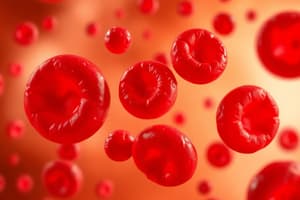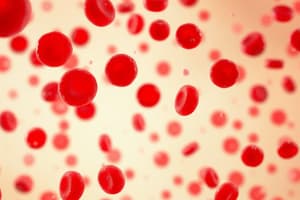Podcast
Questions and Answers
What characterizes anemia in terms of blood parameters?
What characterizes anemia in terms of blood parameters?
- Decreased RBC count (correct)
- Increased hemoglobin levels
- Increased white blood cell count
- Increased hematocrit values
Which of the following correctly defines Mean Cell Volume (MCV)?
Which of the following correctly defines Mean Cell Volume (MCV)?
- Percentage of red blood cells in total blood volume
- Concentration of hemoglobin per 100ml of RBC
- Average volume of each RBC (correct)
- Total mass of hemoglobin in RBCs
Which type of anemia is specifically identified as microcytic hypochromic anemia?
Which type of anemia is specifically identified as microcytic hypochromic anemia?
- Iron deficiency anemia (correct)
- Aplastic anemia
- Vitamin B12 deficiency anemia
- Hemolytic anemia
What is the normal value for Mean Cell Hemoglobin Concentration (MCHC)?
What is the normal value for Mean Cell Hemoglobin Concentration (MCHC)?
How are macrocytic red blood cells classified in terms of MCV?
How are macrocytic red blood cells classified in terms of MCV?
What is the primary cause of Pernicious Anemia?
What is the primary cause of Pernicious Anemia?
Which symptom is associated with anemia as a result of tissue hypoxia?
Which symptom is associated with anemia as a result of tissue hypoxia?
What is the main pathological consequence of Aplastic Anemia?
What is the main pathological consequence of Aplastic Anemia?
What type of anemia results from the excessive breakdown of red blood cells?
What type of anemia results from the excessive breakdown of red blood cells?
Which hereditary disorder is specifically referred to as Congenital Hemolytic Anemia?
Which hereditary disorder is specifically referred to as Congenital Hemolytic Anemia?
What is a typical blood count finding in patients with Aplastic Anemia?
What is a typical blood count finding in patients with Aplastic Anemia?
What is a known cause of Renal Anemia?
What is a known cause of Renal Anemia?
What is a complication resulting from Hemorrhagic Anemia?
What is a complication resulting from Hemorrhagic Anemia?
Which of the following tests would most likely be abnormal in Megaloblastic Anemia?
Which of the following tests would most likely be abnormal in Megaloblastic Anemia?
Which factor is critical for the absorption of Vitamin B12 in the intestine?
Which factor is critical for the absorption of Vitamin B12 in the intestine?
Flashcards
Anemia
Anemia
A condition characterized by a lower-than-normal red blood cell count, hemoglobin level, or hematocrit level, resulting in reduced oxygen-carrying capacity of the blood.
Nutritional Anemia
Nutritional Anemia
Anemia caused by a deficiency of dietary factors essential for red blood cell production. These factors include iron, vitamin B12, folate, and others.
Iron Deficiency Anemia
Iron Deficiency Anemia
A type of anemia characterized by small, pale red blood cells (microcytic), with low hemoglobin content (hypochromic).
Mean Cell Volume (MCV)
Mean Cell Volume (MCV)
Signup and view all the flashcards
Mean Cell Hemoglobin Concentration (MCHC)
Mean Cell Hemoglobin Concentration (MCHC)
Signup and view all the flashcards
Mean Cell Hemoglobin (MCH)
Mean Cell Hemoglobin (MCH)
Signup and view all the flashcards
What is Pernicious Anemia?
What is Pernicious Anemia?
Signup and view all the flashcards
What is Intrinsic Factor?
What is Intrinsic Factor?
Signup and view all the flashcards
What is Aplastic Anemia?
What is Aplastic Anemia?
Signup and view all the flashcards
What is Hemolytic Anemia?
What is Hemolytic Anemia?
Signup and view all the flashcards
What is Sickle Cell Anemia?
What is Sickle Cell Anemia?
Signup and view all the flashcards
What is Renal Anemia?
What is Renal Anemia?
Signup and view all the flashcards
What is Hemorrhagic Anemia?
What is Hemorrhagic Anemia?
Signup and view all the flashcards
What is Tissue Hypoxia?
What is Tissue Hypoxia?
Signup and view all the flashcards
How does the body compensate for anemia?
How does the body compensate for anemia?
Signup and view all the flashcards
Explain the viscosity of blood in anemia.
Explain the viscosity of blood in anemia.
Signup and view all the flashcards
Study Notes
Erythrocyte Part 2
- Objectives for the student include defining anemia, differentiating anemia types, identifying and using MCV, MCH, and MCHC values, defining polycythemia, differentiating between primary and secondary polycythemia, and recognizing the effects of anemia and polycythemia on the body.
Anemia
- Anemia is defined by decreased hemoglobin, reduced red blood cell (RBC) count, and decreased hematocrit (PCV) below the normal range for age and sex. This leads to a lower oxygen-carrying capacity in the blood.
- Criteria for anemia include low hemoglobin (Hb), low hematocrit (Hct), and low RBC count.
Differentiating Anemia Causes
- Hemoglobin, RBC, and PCV (Hematocrit) are used to distinguish between different anemia causes.
- MCV (Mean Cell Volume), MCH (Mean Cell Hemoglobin), and MCHC (Mean Cell Hemoglobin Concentration) are further diagnostic tools for different anemia types.
RBC Indices
- MCV measures the average red blood cell volume. Normal MCV is 90 fL (or 90 µ³). MCV above 95 fL indicates macrocytes, while MCV below 80 fL indicates microcytes.
- MCH measures the average hemoglobin concentration in each red blood cell. Normal MCH is 30 picograms (pg).
- MCHC measures the average concentration of hemoglobin in red blood cells. Normal MCHC is 30 grams/100ml of red blood cells.
Nutritional Anemia (Iron Deficiency)
- Nutritional anemia is caused by a lack of essential nutrients for red blood cell production (erythropoiesis).
- Iron deficiency leads to microcytic hypochromic anemia, characterized by small, pale red blood cells with low hemoglobin.
- Iron deficiency anemia is common in pregnant women, exclusively breastfed babies, and the elderly with gastrointestinal (GIT) cancers.
Pernicious Anemia
- Pernicious anemia is a type of vitamin B12 deficiency.
- Vitamin B12 absorption requires intrinsic factor, produced by parietal cells in the stomach, for absorption in the terminal ileum of the intestines.
- Autoimmune destruction of parietal cells can cause pernicious anemia, leading to vitamin B12 deficiency.
Aplastic Anemia
- Aplastic anemia arises from bone marrow failure to produce red blood cells, even with sufficient nutrients.
- Causes of aplastic anemia include exposure to X-rays, radiation (e.g., from bomb blasts), chemotherapy for cancer, and certain drugs and infections.
Hemolytic Anemia
- Hemolytic anemia results from excessive breakdown of red blood cells.
- Causes of hemolytic anemia include malaria, mismatched blood transfusions, drugs, and congenital hemolytic anemias (e.g., sickle cell anemia).
Sickle Cell Anemia
- Sickle cell anemia is a hereditary disorder.
- A defective hemoglobin β chain (where valine replaces glutamate at position 6 in the amino acid chain) causes red blood cells to have a sickle shape. This results in excessive red blood cell breakdown.
Renal Anemia
- Kidney disease can cause anemia due to decreased erythropoietin secretion.
Hemorrhagic Anemia
- Hemorrhagic anemia results from blood loss.
- Causes include acute blood loss (e.g., car accidents) and chronic blood loss (e.g., heavy menstrual cycles).
Effect of Anemia
- Anemia causes tissue hypoxia (decreased oxygen delivery).
- To compensate, the body increases cardiac output.
- Anemia decreases blood viscosity to 1.5 times that of water (normal is 2.5–3 times water), decreasing peripheral resistance, increasing blood flow, and increasing venous return to the heart, which increases cardiac output and heart rate.
Symptoms of Anemia
- Anemia symptoms include fatigue, poor exercise tolerance, palpitations, pale skin and mucous membranes, and jaundice.
Anemia Treatments
- Anemia treatments depend on the cause.
- Treatments may include iron, vitamin B12, folic acid supplements, blood transfusions, and bone marrow transplantation.
Polycythemia
- Polycythemia is characterized by an increased number of red blood cells and increased hematocrit.
- Two types exist: primary and secondary.
Primary Polycythemia
- Primary polycythemia is a tumor-like condition of the bone marrow, which increases red blood cell production.
- Patients have a higher RBC count, potentially reaching 11 million/mm³, and an elevated hematocrit (70–80%).
Secondary Polycythemia
- Secondary polycythemia results from decreased oxygen delivery to tissues.
- This can occur in those living at high altitudes (due to lower air oxygen levels) or those with chronic lung disease or heart failure.
- RBC count may be 6 to 8 million/mm³.
Relative Polycythemia
- Relative polycythemia occurs when body fluid is lost without a concurrent loss of red blood cells, such as in diarrhea or heavy sweating, which decreases plasma volume. Red blood cells are concentrated in a smaller plasma volume.
Effect of Polycythemia
- Polycythemia increases blood viscosity, leading to sluggish blood flow.
- Increased viscosity causes increased peripheral resistance, resulting in increased blood pressure, present in one-third of polycythemic individuals.
Classroom Question
- How do you differentiate between the causes of anemia due to increased destruction versus decreased production?
Case Study
- A 58-year-old male with fatigue, headaches, shortness of breath, nausea, vomiting, and dark stools, who smokes heavily, and has pale, cachectic, and tachycardia features, is presented.
- Laboratory investigations show low hemoglobin (Hb), low mean corpuscular volume (MCV), low mean corpuscular hemoglobin (MCH), and low mean corpuscular hemoglobin concentration (MCHC).
Lab Investigations
- Hemoglobin (Hb): 10g/dL (normal range 14-16 g/dL)
- Mean corpuscular volume (MCV): 60 femtolitres (fL) (normal range 80-95 fL)
- Mean corpuscular hemoglobin (MCH): 22 picograms (pg) (normal range 25-32 pg)
- Mean corpuscular hemoglobin concentration (MCHC): 30% (normal range 32-36%)
References
- Anemia - AMBOSS
- Human Physiology by Lauralee Sherwood, seventh edition
- Physiology by Guyton & Hall, 11th edition
- Physiology by Linda S. Contanzo, third edition
- Physiology by Berne and Levy, sixth edition
Studying That Suits You
Use AI to generate personalized quizzes and flashcards to suit your learning preferences.




